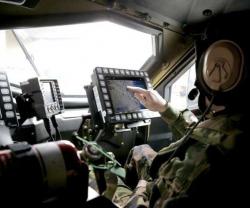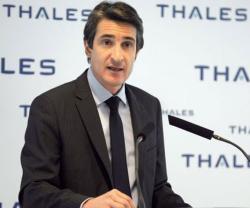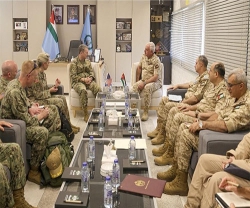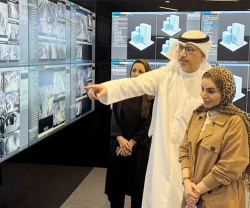Thales to Supply Night Vision Goggles to Gladius Project
09.01.2013 Europe
As part of the “Gladius” project, Thales has received the sub-contract from Rheinmetall Defence to manufacture and supply 310 night vision goggles of type Lucie II D and 16 IR modules for 30 combat systems of the “Infantry Soldier of the Future” (IdZ 2).
In addition, Thales will supply this highly modern combat gear with 300 UHF radios of type SOLAR 400 EG-E (30 combat systems), lithium-ion batteries as the power supply for the entire electronic backbone, charging stations, antenna kits and adapters and cables. The order has a volume of roughly EUR 7.5 million, and, in addition to the logistics documentation and training, also includes the option for a second lot of 600 goggles, 192 IR modules and 600 radios.
Lucie II D, from the image amplifier family made by Thales under the same name, is configured with a modular design. As the standard night vision goggle of the Bundeswehr, Lucie is a device highly accepted by soldiers. In addition to the optical performance enhancement of the night vision component as compared to the base model, the newly developed goggle for the IdZ 2 has an integrated OLED technology based data and video display.
The modularity and the wide field of vision of 51 degrees enable highly flexible deployment with respect to mobility, observation / identification and effectiveness. Moreover, a completely new device - Lucie II DIR – is created by the simple adaptation of the IR module to the goggle. This creates an image overlay with residual light and thermal image. The modular configuration and the enhanced functionality in combination with the compact design, low weight, high reliability, high wear comfort and low power consumption (using commercially available AA batteries), unlock entirely new deployment concepts.
This first of its kind rollout of the Lucie II DIR device significantly enhances the reconnaissance performance and night-combat capabilities for the soldier's mission. The "Lateral Module" is used to create the interface to the soldier's "Body Net" in the IdZ 2. This provides the following functions: Night vision only or image display only, for instance of terrain layouts, maps and map sections, or mixed-mode image operation, i.e. night vision including overlay of tactical and status information in the upper or lower display area.
The UHF group radio, SOLAR 400EG-E, is the centerpiece of the communications gear for the “Gladius” project. Its integrated, high-performance communications processor is fully IP capable, and has a total of three interfaces to establish links respectively to the central processor on the soldier's back, to the vehicle in mounted operation, and to the VHF lead radio in the case of the team leader.
At 384 kbit/s on the air interface, SOLAR 400 EG-E permits the simultaneous transmission of voice and data between soldiers in the group on three logical channels at a range of up to two kilometers (700 meters in urban terrain). Voice is transmitted at high-quality duplex mode, i.e. group members can speak and hear at the same time. With a one watt transmission rating, the SOLAR 400EG-E covers the entire frequency spectrum from 225-400 MHz. The optimized antenna location behind the soldier's shoulder ensures the maximum range while also adhering to applicable health regulations.
The wave form is implemented by software, is adaptable to changing requirements and, if needed, can also be ported to SVFuA, the German Software Defined Radio. Two Li-Ion batteries with integrated SM bus provide the central, uninterruptible power supply of the control and communications system on the soldier's body. The batteries are equipped with a charge status indicator, and can be exchanged during operation due to the redundant design.
In addition, Thales will supply this highly modern combat gear with 300 UHF radios of type SOLAR 400 EG-E (30 combat systems), lithium-ion batteries as the power supply for the entire electronic backbone, charging stations, antenna kits and adapters and cables. The order has a volume of roughly EUR 7.5 million, and, in addition to the logistics documentation and training, also includes the option for a second lot of 600 goggles, 192 IR modules and 600 radios.
Lucie II D, from the image amplifier family made by Thales under the same name, is configured with a modular design. As the standard night vision goggle of the Bundeswehr, Lucie is a device highly accepted by soldiers. In addition to the optical performance enhancement of the night vision component as compared to the base model, the newly developed goggle for the IdZ 2 has an integrated OLED technology based data and video display.
The modularity and the wide field of vision of 51 degrees enable highly flexible deployment with respect to mobility, observation / identification and effectiveness. Moreover, a completely new device - Lucie II DIR – is created by the simple adaptation of the IR module to the goggle. This creates an image overlay with residual light and thermal image. The modular configuration and the enhanced functionality in combination with the compact design, low weight, high reliability, high wear comfort and low power consumption (using commercially available AA batteries), unlock entirely new deployment concepts.
This first of its kind rollout of the Lucie II DIR device significantly enhances the reconnaissance performance and night-combat capabilities for the soldier's mission. The "Lateral Module" is used to create the interface to the soldier's "Body Net" in the IdZ 2. This provides the following functions: Night vision only or image display only, for instance of terrain layouts, maps and map sections, or mixed-mode image operation, i.e. night vision including overlay of tactical and status information in the upper or lower display area.
The UHF group radio, SOLAR 400EG-E, is the centerpiece of the communications gear for the “Gladius” project. Its integrated, high-performance communications processor is fully IP capable, and has a total of three interfaces to establish links respectively to the central processor on the soldier's back, to the vehicle in mounted operation, and to the VHF lead radio in the case of the team leader.
At 384 kbit/s on the air interface, SOLAR 400 EG-E permits the simultaneous transmission of voice and data between soldiers in the group on three logical channels at a range of up to two kilometers (700 meters in urban terrain). Voice is transmitted at high-quality duplex mode, i.e. group members can speak and hear at the same time. With a one watt transmission rating, the SOLAR 400EG-E covers the entire frequency spectrum from 225-400 MHz. The optimized antenna location behind the soldier's shoulder ensures the maximum range while also adhering to applicable health regulations.
The wave form is implemented by software, is adaptable to changing requirements and, if needed, can also be ported to SVFuA, the German Software Defined Radio. Two Li-Ion batteries with integrated SM bus provide the central, uninterruptible power supply of the control and communications system on the soldier's body. The batteries are equipped with a charge status indicator, and can be exchanged during operation due to the redundant design.
Previous PostIndia Selects Airbus Military A330 MRTT
Latest news
Latest events
DefenPol China2025 - 7th Guangzhou International Defense & Police Exhibition & Summit
11 - 12 Jul 2025Nan Fung International Convention & Exhibition Center (NICEC) - ChinaIDEF 2025 Turkey - International Defence Industry Fair
22 - 27 Jul 2025Istanbul Expo Center - TurkeyDSEI 2025
09 - 12 Sep 2025Excel, London - United KingdomIntersec Saudi Arabia
29 Sep - 01 Oct 2025Riyadh International Exhibition & Convention Centre - Saudi Arabia






















